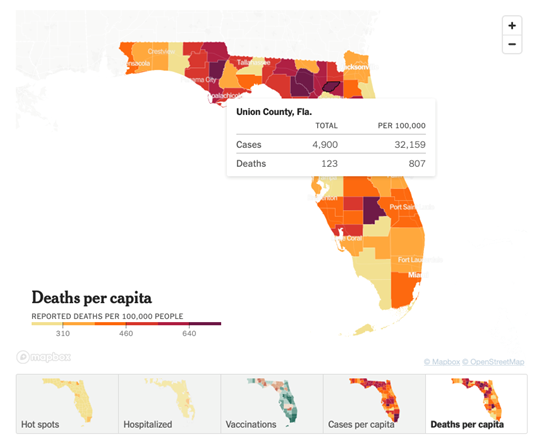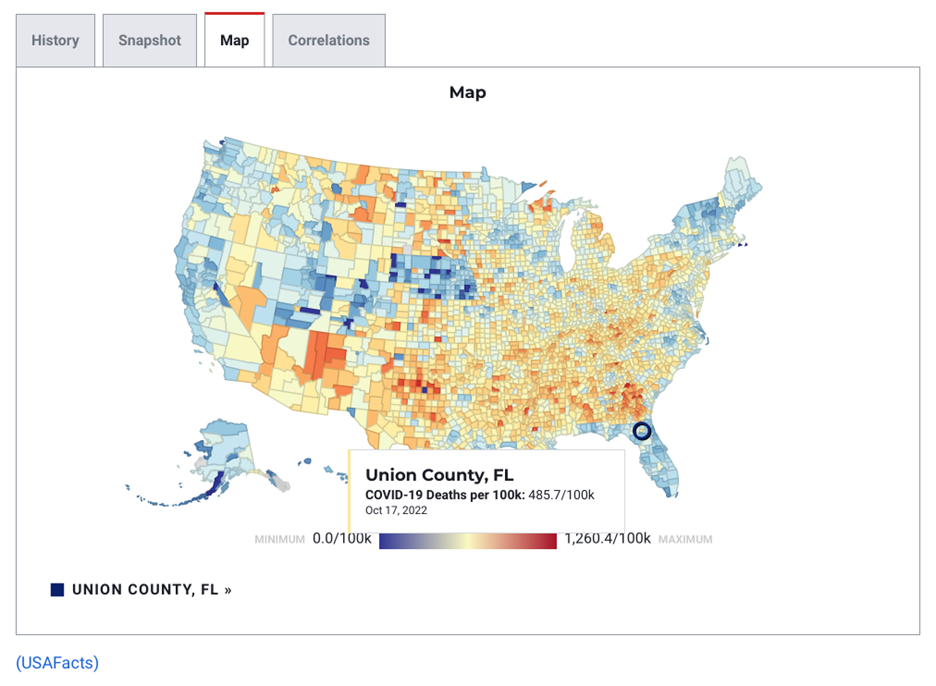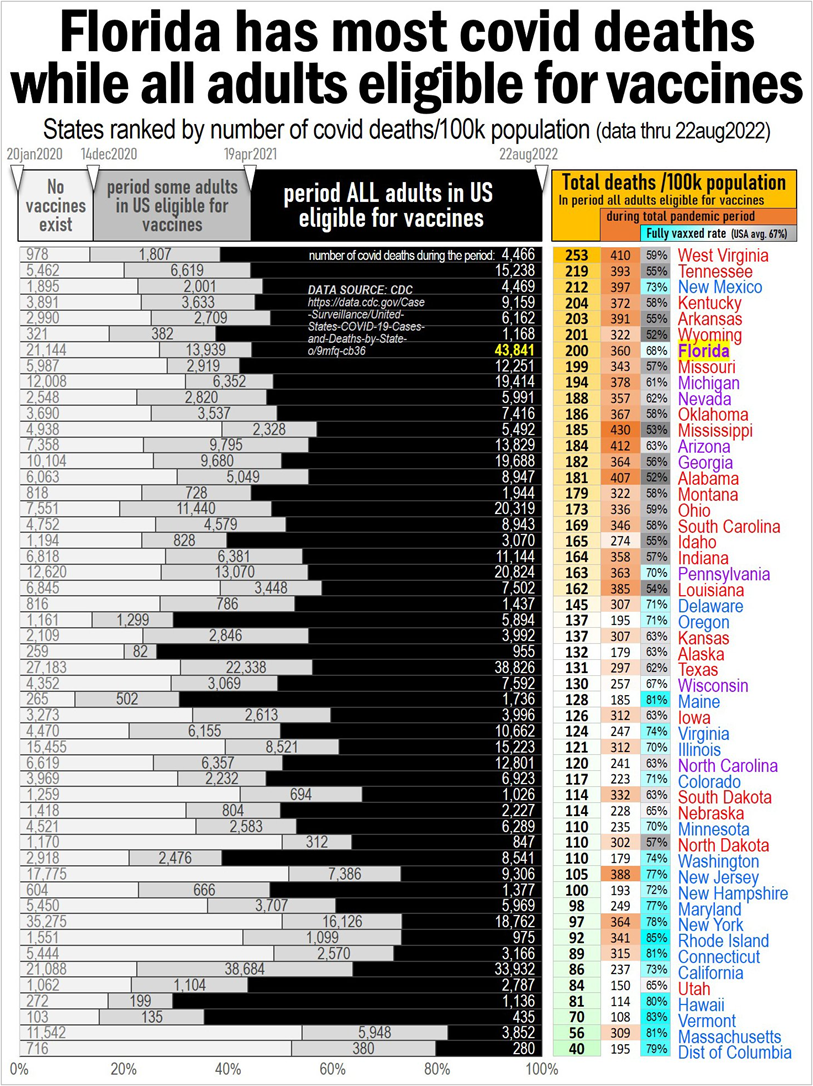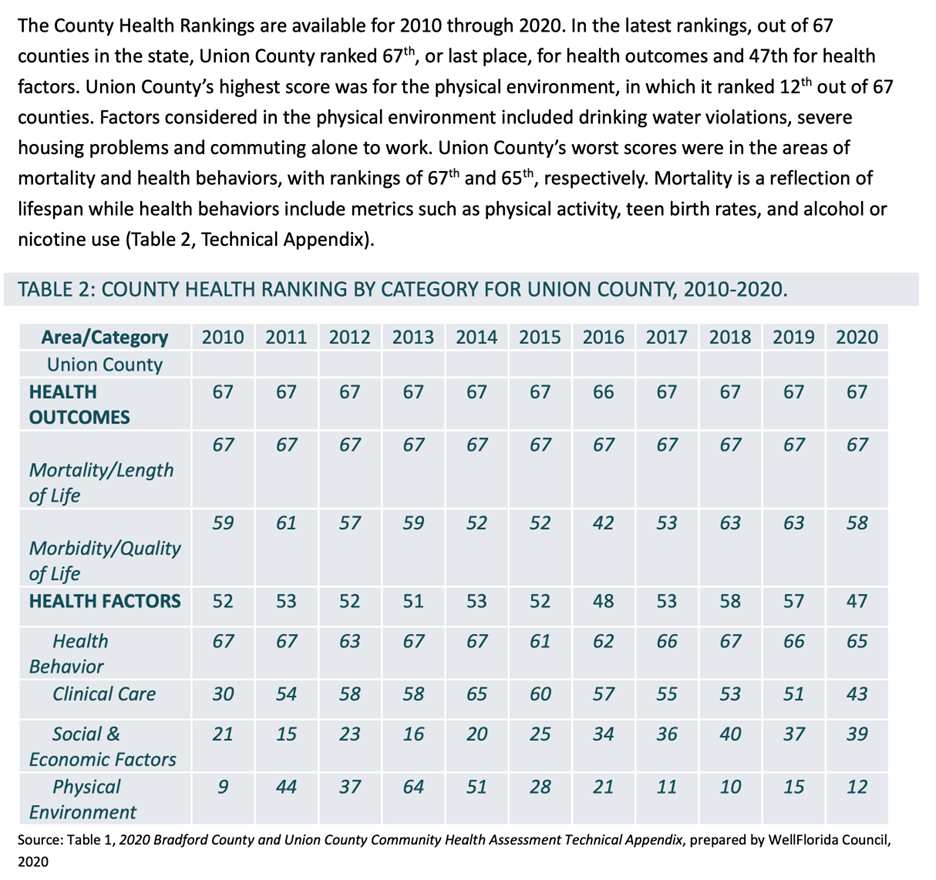When John Mousseau, Patty Healy, and I discussed ESG factors at the Rowan University-GIC conference, we and others tried to explain the multifactor analysis used in applying the tools of ESG. We will be offering videos of the conference in a future part of the ESG series. John explained how ESG plays an important role in municipal finance; Patty demonstrated the use of ESG factors by Moody’s rating service.

We also noted that not all ESG multi-factor analysis is directed at buy, sell, or hold decisions about a marketable security. Business decision-making ESG applications are also about labor force content and business facility location and business operational risk. Today, we want to demonstrate that type of analysis with a case study that doesn’t get muddied by a security buy, sell, hold decision. So, for this part 4 of our ESG series, there is no security.
This Sunday, we examine Union County in Florida, a place where most readers have not likely visited during their travels to and within Florida. Remember, the Union County case study is not an ESG investing-focused example. There is no publicly traded security to evaluate. There are no credit ratings; there is no debt in the traditional municipal bond sense. No rating agency like Standard & Poor's or Moody's or Fitch or Kroll is involved to assess the economic risk factors; this is not about a municipal or corporate entity’s likely ability to pay principal or interest on a bond. Credit rating agencies apply ESG factor analysis because they are paid to do so. In Union County there is no reason for the county to pay them.
So, why even look at this very small Florida county, one of 67? Read on (12 more minutes) and you may see why the ESG factors become important.
In 2017, Union County was found to have the highest per capita lung cancer death rate in the country (“Study: Union County has nation's highest death rate from lung cancer,” https://www.actionnewsjax.com/news/local/study-union-county-has-nations-highest-death-rate-from-lung-cancer/487595263/). In 2020, per capita age-adjusted cancer deaths in Union County — 392 per 100K — exceeded (by far) per capita age-adjusted cancer deaths in every other Florida county (“Deaths from Cancer,” https://www.flhealthcharts.gov/ChartsReports/rdPage.aspx?rdReport=Death.DataViewer&cid=0097).
Back in August (2022), another statistic caught our attention: Union County topped the list for Covid deaths per capita in Florida (“Counties with the highest COVID-19 death rate in Florida” (https://stacker.com/florida/counties-highest-covid-19-death-rate-florida).
So, what was (is) going on?
The fact that Union County ranked at the top of both lists set off an alarm. Those statistics made the ESG screens that are used when we look at all 3000 counties in the United States. They are guidance for security examination, but they are also used for business consulting decisions.
Example, would you want to locate your factory near the highest cancer death rate area if the employees you were going to hire came from the area? Would you wonder about the E because of some environmental hazard that is causing death? Are there other factors that would impact the social (S) issues? For example, high death rates often imply the possibility of high disability rates (hard to determine causality). Does that portend that your new factory labor force would have a high rate of absenteeism? Does it mean that your labor force may include a higher number of caregivers who must care for sick and dying people at home? And then there is the G, which deals with the governance that may or may not contribute to the high death rates. Who (or what circumstance) is responsible for the high death rates?
Before you make business decisions regarding locating your new factory in Union County, you would want to know why circumstances are as they are. So, here’s an ESG factor array to help guide a non-portfolio investment decision that would determine a business location and hiring decision.
Here’s what we found about Union County, Florida. We are trying to cite sources of every item.
Union County is home to an estimated 16,335 residents as of July 2021, according to the Census Bureau (https://www.census.gov/quickfacts/unioncountyflorida). It is the smallest county in the state of Florida (https://en.wikipedia.org/wiki/Union_County,_Florida).
Here's the link for the county website: https://unioncounty-fl.gov. The county’s mission statement speaks to its aspirations: “To provide quality growth of our community in a personal, responsive, and innovative manner, to instill leadership necessary to advance a safe and sustainable community, maintain a high quality of life, operate in a manner that is worthy of public trust, respect our rural heritage, and to protect our natural environment for present and future generations.”
The county has no bonded debt. For its 2021 financial statements, see Florida Auditor General - E-Files (flauditor.gov) or 2021 union county (flauditor.gov).
Life expectancy in Union County, Florida, turns out to be 68.3 years (https://www.usnews.com/news/healthiest-communities/florida/union-county). That's about the same life expectancy we find in Micronesia or Madagascar and more than a percentage point lower than life expectancy in Rwanda and Botswana (https://www.worldometers.info/demographics/life-expectancy/).
Let’s look first at E. Is there an environmental circumstance in Union County that is responsible for its high per capita cancer deaths? Is there some activity in the county that causes the high incidence of cancer? The small city of Raiford managed to elude becoming Florida’s first toxic waste incinerator site in the early 1990s. Union County is not home to a Superfund site. Other than the prison system, agriculture, and timber are the biggest economic activities. Though chemicals used on certain crops are associated with higher rates of cancer, there’s no environmental factor that explains the county’s exceptionally high cancer rate. What the E in ESG does is to call attention to the statistics. The E evaluates the statistical evidence and leaves it to others to determine the cause.
So, what is going on in Union County? Here is a key factor. Union County's largest employer is the Florida state prison system. The Union Correctional Institution, a maximum-security prison that includes prisoners on death row, and the Reception and Medical Center (RMC) are located there. Variously known in the past as the Florida State Prison, Raiford Prison, and State Prison Farm, the Union Correctional Institution is a Florida Department of Corrections state prison (“Union Correctional Institution,” https://en.wikipedia.org/wiki/Union_Correctional_Institution).
The prison system is the largest single source of economic strength in the county. There are, of course, some other businesses and activities. The oversight of the major employer in Union County, FL, is the state of Florida and its Department of Corrections (“Major Employers in Union County,” https://nflp.org/images/properties/Union_County_Major_Employers.pdf).
In Union County, the incarceration rate is 29.45% (“These 10 U.S. Counties Have the Highest Incarceration Rates,” https://www.usnews.com/news/health-news/articles/2021-10-04/the-10-us-counties-with-the-highest-incarceration-rates). That is the 9th highest incarceration rate in the US. The county with the highest incarceration rate – 48% – is Crowley County, Colorado, which has seen 511 deaths per 100K during the pandemic (“Tracking Coronavirus in Crowley County, Colo.: Latest Map and Case Count,” https://www.nytimes.com/interactive/2021/us/crowley-colorado-covid-cases.html).
The size of the prison population has everything to do with the county’s labor participation rate statistics and much to do with its low per capita income. Union Correctional Institution has housed only men since 1954 (“Union Correctional Institution,” https://en.wikipedia.org/wiki/Union_Correctional_Institution). The county’s Labor Force Participation Rate is 27% for men and 67.2% for women, for a total of 38.8% (“Labor Force Participation Rate by Sex, State and County,” https://www.dol.gov/agencies/wb/data/labor-force-participation-rate-by-sex). The national Labor Force Participation Rate, by contrast, is 62.3% (https://fred.stlouisfed.org/series/CIVPART). Florida’s statewide Labor Force Participation Rate is 59.5% (“Labor Force Participation Rate for Florida,” https://fred.stlouisfed.org/series/LBSSA12). The fact that Florida is a mecca for retirees is, no doubt, reflected in this statistic.
Wikipedia lists Union County, Florida, as the 4th poorest county in the US (https://en.wikipedia.org/wiki/List_of_lowest-income_counties_in_the_United_States). A quick look at Wikipedia’s list, however, provides some insight. Many of the counties listed are home to large prisons.
A 2017 Business Insider article reported that the State of Florida moved cancer patients to the Union Correctional Institution, concentrating them in one location. Why? We'll leave that to readers to determine. Perhaps to concentrate treatment services there? See “A Florida county of 15,000 people is the least healthy place in America — here's why,” https://www.businessinsider.com/union-county-is-least-healthy-in-us-2017-10.
Is the factor that makes Union County, FL, number one in the United States for lung cancer deaths primarily the presence of the prison and its concentration of cancer victims who happen to be prisoners in the Florida system? Interestingly, incarceration and a higher rate of mortality from cancer go hand in hand, and not just in Florida. See “Disparities in cancer prevalence, incidence, and mortality for incarcerated and formerly incarcerated patients: A scoping review,” (https://www.ncbi.nlm.nih.gov/pmc/articles/PMC8525139/). That statistic points to social ills that play out in two different kinds of negative outcomes. That’s S on a macro ESG scale — a societal ill to address.
Beyond the concentration of imprisoned cancer patients, another factor in the county’s high lung cancer death rate may be that the percentage of smokers in the county is relatively high compared to the national median of 20%. In 2019, 32.4% of the population smoked, according to the Florida Department of Health. (“Adults who are current smokers,” https://www.flhealthcharts.gov/ChartsReports/rdPage.aspx?rdReport=BrfssCounty.DataViewer&bid=8).
The Union County lung cancer death rate remains a subject for discussion and debate, but the Business Insider article cited above (https://www.businessinsider.com/union-county-is-least-healthy-in-us-2017-10) offers some insights, suggesting that poverty and a low budget for the Public Health department were additional factors.
We looked, too, at the per capita Covid death rate in Union County, FL. According to the NY Times, Union County has seen 807 deaths per 100K as of October 21, 2022.

(https://www.nytimes.com/interactive/2021/us/florida-covid-cases.html)
But when we checked a different source, we found a glaring disparity in the data. That’s why all items in the ESG multi-factor list require research. There’s peril in relying on a single data point. Union is a perfect example. Here’s a map from US News and World Report, based on data from USA Facts.

To understand the discrepancies we see here, we need to understand the methodologies that produced the statistics depicted on each map. What population figure was used for the county? (Do a Google search, and you’ll find that population figures for this small Florida county vary by more than a thousand people, depending on the source.) Was the prison population included? Where did the numbers for Covid deaths come from? Since USA Facts reports 74 Covid deaths in Union County while the NY Times reports 123 Covid deaths, that last question becomes important. (https://usafacts.org/visualizations/coronavirus-covid-19-spread-map/state/florida/county/union-county, https://news.google.com/covid19/map?hl=en-US&mid=%2Fm%2F0j_1f&gl=US&ceid=US%3Aen).
We asked USA Today to help us. Here’s their response:
“Yes! Both New York Times and our data use the same population statistic, which is Census-confirmed county level populations here: https://www.census.gov/data/datasets/time-series/demo/popest/2010s-counties-total.html. However, our numbers rely on exclusively governmentally-verified data, and the latest reading on Covid-19 related deaths verified by the Florida State Department of Health was published in May. The discrepancy would be due to the mathematical alterations on CDC data that allow NYT to provide an estimate of daily running totals. For questions on covid-related prison deaths, this article delves into nuances within the Bureau of Justice Statistics and links to a few data sources that might be integral to the work being done here: https://usafacts.org/articles/how-many-people-in-prisons-died-of-covid-19/.”
We thank USAfacts.org for helping clarify this issue. Now let’s segue to other data.
Moody’s rating serve looks at the S of social in their ESG rating discussions of Covid, so we did the same.
We sought out the Covid vaccination and booster rates. At one time, Union County, FL, had among the lowest Covid vaccination and Covid booster rates; but at this point, 53% of residents six months or older are vaccinated and have one booster. Nineteen Florida counties now have lower vaccination rates. Florida’s overall vaccination rate is 72%. (http://ww11.doh.state.fl.us/comm/_partners/covid19_report_archive/covid19-data/covid19_data_latest.pdf).
What about the role of the prison? Despite prisoner releases precipitated by the pandemic, Covid hit prisons hard in Florida as it did elsewhere in the United States. A prison is a viral petri dish, much as a cruise ship is; but while cruise ships stopped sailing, prisons had to carry on. The life expectancy for prisoners in Florida decreased by four years during the first year of the pandemic. See “New data gives a detailed picture of how COVID-19 increased death rates in Florida prisons,” https://www.prisonpolicy.org/blog/2021/04/27/florida-prison-mortality/. Community spread may have accompanied spread in the prison because of the number of prison employees in the county. We do not have a detailed picture.
We also note that poorer communities have suffered more acutely during the pandemic than wealthier ones have. See “Poor counties nationwide (including Florida) had higher COVID-19 death rates compared to wealthier counties” (https://floridapolitics.com/archives/514370-poor-counties-nationwide-including-florida-had-higher-covid-19-death-rates-compared-to-wealthier-counties/), along with “A Poor People's Pandemic Report: Mapping the Intersection of Poverty, Race and COVID-19,” (https://sdsn.maps.arcgis.com/apps/dashboards/5f63359b4889476380d12b1cb5299f3d).
Union County, Florida, like many other rural places across the US, is a medically underserved area (“MUA Find,” https://data.hrsa.gov/tools/shortage-area/mua-find).
Finally, there is accumulating national data that shows that political affiliation is, in fact, associated with differing Covid death rates. See “The Changing Political Geography of COVID-19 Over the Last Two Years,” https://www.pewresearch.org/politics/2022/03/03/the-changing-political-geography-of-covid-19-over-the-last-two-years/. Also see “Excess Death Rates for Republicans and Democrats During the COVID-19 Pandemic,” https://www.nber.org/papers/w30512. A lot depends on the public health policy in a given state or local jurisdiction, but the aggregate data speak directly to this issue.
When you look at Union County, Florida, there is a political aspect that supports the national data observation. Union County, Florida, was about 80-20 favoring Republicans in the 2020 election. But we wondered if the Covid death rate was driven by the presence of the prison and if that had any impact on the results (“Florida Presidential County Results, ” https://abcnews.go.com/Elections/florida-county-presidential-election-results-2020).
For this reason, we also looked at Union County, Georgia. It also split about 80-20 favoring Republicans in the 2020 election (https://abcnews.go.com/Elections/georgia-county-presidential-election-results-2020. It has experienced 694 Covid deaths per 100K according to the NY Times data; this is similar to numbers for Florida’s Union County, though it falls in the middle of the high estimate from the NY Times and the low estimate from US News and World Report. Union County, Georgia, is also designated as medically underserved. Note, however, that Union County, Georgia, lacks the large prison population that Union County, Florida, has.
Now let’s turn to governance, the G in ESG. If you delve into the Union County website and look at county governance, you will see that the county is trying to put its best foot forward and attract new businesses: https://discoverunionfl.com. The county is also applying for $2 million in federal funding from the Rebuild Florida General Infrastructure Program to build an emergency storm shelter (“Public Notice of Grant Application for the REBUILD FLORIDA CDBG-MITIGATION GENERAL INFRASTRUCTURE PROGRAM for Union County, Florida,” https://unioncounty-fl.gov/wp-content/uploads/Notice-of-Grant-Application-Rebuild-FL-CDGB-Grant.pdf).
A visitor to the county’s public health department website (https://union.floridahealth.gov) currently sees guidance about controlling mosquitoes, washing hands to prevent hepatitis, using a generator safely, and getting a flu shot. The only mention of Covid is a link to State Surgeon General Joseph Lapado’s new guidance discouraging men ages 18–39 from getting the mRNA Covid vaccines.
By the way, that guidance also appears on other county-level Florida Department of Public Health websites, including Sarasota County’s. An abundance of research commentary has disparaged the research that Lapado cites. See “Scientists dispute the Florida surgeon general's latest COVID-19 vaccine guidance for young men,” https://www.politico.com/news/2022/10/11/medical-experts-reject-florida-surgeon-generals-covid-vaccine-guidance-00061352.
Nothing on the Florida Health Union County home page addresses lifestyle factors that would affect the incidence of cancer, and the word cancer does not appear. There is no mention of where or how or why to get a bivalent Covid booster, either.
Lastly, when it comes to G, we must turn to nearby Tallahassee, FL. What's their role? What's their oversight? The G in governance becomes critical in Union County, FL, and all the assessments made of it. Florida is not a state known for an especially high rate of cancer compared to other states. The risk seems to be concentrated in a poor rural county with a sizable prison population.
The State of Florida has fared less well with Covid death rates. This is especially so after vaccines became widely available. Here’s a comparative chart based on CDC data:

Chart designed by @CanDoChiChi (https://twitter.com/CanDoChiChi/status/1562240990869884928?s=20&t=824GCl1xJKTQepY9I71tig)
The CDC data source is here: https://data.cdc.gov/Case-Surveillance/United-States-COVID-19-Cases-and-Deaths-by-State-o/9mfq-cb36.
Readers will have to determine for themselves what role governance in Tallahassee has had in Covid outcomes across the state.
ESG is an analytical framework that enables us to ask questions relevant to outcomes in the past and anticipated outcomes for the future. These questions apply not only to investing but to health. In North Florida, the Florida Department of Health has engaged the nonprofit WellFlorida Council (https://www.wellflorida.org) to take a much deeper dive into health-related dynamics in Union County, with an eye toward bettering health outcomes for Union County residents. You will see ESG factors reflected in their detailed report. Here’s an excerpt and a chart, but there is much more to delve into in the full report:

(“Union County Community Health Assessment, ” https://www.floridahealth.gov/provider-and-partner-resources/community-partnerships/floridamapp/state-and-community-reports/union-county/_documents/Union_CHA3.pdf)
When we look at Florida’s smallest county’s vulnerability to both lung cancer and Covid, we don’t see one factor alone in play. We see factors that have resulted in higher death rates for lung cancer and some other cancers and likely, too, for Covid. We note the role that the large prison population, with a concentration of cancer patients, plays in the county’s statistics. We wish Union County the best as it seeks $2 million for a storm shelter, and we wonder what a stronger shelter might look like for other kinds of storms, such as chronic or infectious disease.
ESG is a multi-factor analytic system. It helps you “look” at data and frame questions. It doesn’t decide for you. But it does help you make decisions for yourself. After you read this, ask yourself if you would locate your new factory nearby Union County. Ask how you would screen and hire a new labor force. Those are the tangible business decisions being made every day by entrepreneurs who use ESG factors continually.
Thanks for taking some time to examine the ESG issues. We will continue this series for a while and cite future case studies of all types.
Parts 1–3 of the series may be found here:
ESG-Part 1: Introduction and October 14 Conference Information
https://www.cumber.com/market-commentary/esg-part-1-october-14-conference-information
ESG-Part 2: Jackson, Mississippi
https://www.cumber.com/market-commentary/esg-part-2-jackson-mississippi
ESG Part 3: The Florida Debate
https://www.cumber.com/market-commentary/esg-part-3-florida-debate-0
ESG: Readers Respond re Jackson
https://www.cumber.com/market-commentary/esg-readers-respond-re-jackson
David R. Kotok
Chairman & Chief Investment Officer
Email | Bio
Links to other websites or electronic media controlled or offered by Third-Parties (non-affiliates of Cumberland Advisors) are provided only as a reference and courtesy to our users. Cumberland Advisors has no control over such websites, does not recommend or endorse any opinions, ideas, products, information, or content of such sites, and makes no warranties as to the accuracy, completeness, reliability or suitability of their content. Cumberland Advisors hereby disclaims liability for any information, materials, products or services posted or offered at any of the Third-Party websites. The Third-Party may have a privacy and/or security policy different from that of Cumberland Advisors. Therefore, please refer to the specific privacy and security policies of the Third-Party when accessing their websites.
Cumberland Advisors Market Commentaries offer insights and analysis on upcoming, important economic issues that potentially impact global financial markets. Our team shares their thinking on global economic developments, market news and other factors that often influence investment opportunities and strategies.

